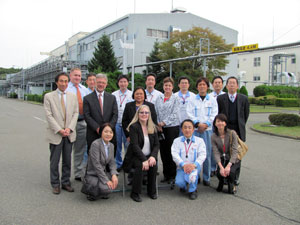USAMMDA Site Assessment Team Travels to Japan to Assess Arbekacin Manufacturing Facilities

The U. S. Army Medical Materiel Development Activity site assessment team for Arbekacin visited three Meiji Seika Pharma facilities in Japan, Oct. 15-21, to determine acceptability of Meiji's antibiotic Arbekacin manufacturing capabilities supporting the protocol "Treatment Protocol for the Use of Arbekacin in Adult Patients with Infections Caused by Multi-drug Resistant Bacteria".
During the site assessment, the team visited three facilities: the Meiji headquarters in Tokyo, the initial drug product facility in Kitakami, and the final drug product facility in Odawara.
"The assessment of these facilities is vital to due diligence for the U.S. Army to ensure proper quality of this antibiotic when used in the treatment of the Wounded Warriors," said Christa Madock, site assessment team leader and product manager for the Force Health Protection Division at USAMMDA.
The goal of the visit was to confirm that the facilities are compliant with good manufacturing practices that meet U.S. federal regulatory requirements.
"This visit to Meiji was a significant step in support of the tremendous effort set forth by Meiji to make this product available to our Wounded Warriors," said Jane Cook, regulatory affairs scientist for the Division of Regulated Activities and Compliance at USAMMDA. "It was important because we will be submitting an Investigational New Drug application to the FDA for use of Arbekacin in the Infectious Disease Unit of Walter Reed National Military Medical Center in Bethesda, Md. (formerly the Walter Reed Army Medical Center)."
In Tokyo, the team visited Meiji headquarters where they met with Meiji senior leadership to outline the purpose of the visit, introduce the team members, brief updates to legal documents and define drug master file responsibilities.
"As a partner in the development of the Arbekacin drug, Meiji is responsible for maintenance of and updates to the Arbekacin drug master file submitted by them to the U.S. FDA in Oct. 2011."," said Cook.
The team then travelled by Bullet Train to Kitakami, a city about 300 miles North of Tokyo, to tour the manufacturing facility. Here, raw materials are made into the active antibiotic ingredient. This facility produces nine antibiotic active pharmaceutical ingredients, including Arbekacin. Multiple lots of the Arbekacin sulfate active pharmaceutical ingredient are produced each year based on demand, with an average production of four lots.
"Procedures are in place for the qualification of raw materials and supplies," said Madock. "Upon completion of product manufacturing, samples are removed and tested according to predetermined specifications."
Hopping on another Bullet Train, the team then traveled to Odawara, a city about 30 miles South of Tokyo, where the team reviewed the process of transforming the active ingredient into the final drug product which is then prepared for shipment. This facility produces three antibiotics, including Arbekacin.
According to Madock, two of the team members toured the facility, while the remaining team members reviewed selected standard operating procedures and documentation pertinent to the safe and effective handling of Arbekacin.
"Our successful site assessment trip to Japan was punctuated by the hospitality of our Meiji partners, the beautiful and clean country, wonderful weather, and excellent food with chopsticks," said Madock. USAMMDA serves as the sponsor for this protocol and the submission of Arbekacin as an IND to the U.S. Food and Drug Administration.
So why is Arbekacin so important to our military health and operations?
Since the U.S. military's occupation of Afghanistan in 2001, inpatients at the WRAMC have been prone to infections caused by bacteria that are becoming resistant to treatment.
"Given the increasing prevalence of wound infections caused by multidrug-resistant organisms as well as the few new antibiotic classes in Phase 3 clinical studies, the treatment of patients with infections caused by multidrug-resistant organisms poses an increasing challenge," said Madock. "This is especially true in the war-wounded population."
Arbekacin is a semi-synthetic aminoglycoside antibiotic manufactured by Meiji Seika Pharma Co., Ltd. in Japan. Arbekacin is licensed in Japan for the treatment of pneumonia and septicemia caused by methicillin-resistant Staphylococcus aureus, more commonly known as MRSA. Arbekacin was originally synthesized from dibekacin in 1972. In 1990, it was registered and marketed in Japan.
According to Madock, Arbekacin also has a broad spectrum of activity against Gram-negative bacteria including multidrug-resistant organisms isolated from WRAMC inpatients.
The site assessment team included the following USAMMDA team members: Christa Madock; Jane Cook; Maria "Vicky" Price from Clinical Services Support Division; Robert Rice from CSSD; and Jon Witt from the Office of Research and Technology Applications.













